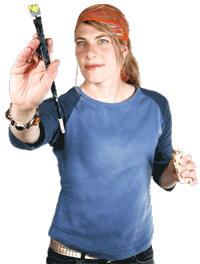At WiseGEEK, we're committed to delivering accurate, trustworthy information. Our expert-authored content is rigorously fact-checked and sourced from credible authorities. Discover how we uphold the highest standards in providing you with reliable knowledge.
What Are the Different Types of Holographic Art?
The unique nature of holographic art and the medium’s capabilities for recreating objects in three dimensions give artists the versatility to interpret old art forms in bold, new ways. Artists have used holograms to create realistic holographic films and illuminated, three-dimensional portraits as well as to form holographic sculptures that seem to rotate as the viewer moves. Some artists have mixed various types of media with holograms that morph real objects with holographic extensions for a uniquely innovative type of holographic art.
Holograms are formed when a laser is used to illuminate an object and the light is recorded on a light-sensitive medium. The reflected light is passed through another light source, and the resulting interference patterns form a holographic image recording that is three-dimensional and can be viewed from different angles as the viewer moves. This technology has inspired artists to innovate and explore types of holographic art using the medium in various capacities that combine art and science.

Holographic art portraiture has the potential to render likenesses of people and animals in such exacting detail that features appear accurate even at the microscopic level. The realism of holographic portraits is enhanced by the fact that the image also appears three-dimensional. Realistic life-like lighting is possible with holographic portraits in a way that isn’t possible with painted portraits. Brightness is not limited to the whiteness of the underlying canvas or paper but is recorded and appears as the eye sees it.
Some artists have embraced holographic art filmmaking by recording holographic images of scenes, objects, and people. Although limited to real objects, some filmmakers use multiple holograms to layer images upon each other so that each image appears to interact with the other. Holographic filmmakers may also use holographic film clips with still sculptures so that the objects or people in the film appear to interact with the still object or scene.
A mixture of holographic art forms and sculpture can result in an object with both a practical and artistic purpose. The Chaos Temple in Holstebro, Jutland, Denmark, is a working television station transmitter that has holographic elements. This holographic sculpture doubles as a city landmark and can be visible even at night.
The use of holograms with real objects can result in holographic multimedia art forms that may not be easily classified. Ikuono Nakamura created an ode to late 19th- and early 20th-century escape artist and magician Harry Houdini called "Materialization" by projecting a holographic image of Harry Houdini’s chained hands emerging from a real milk jug. Holographic multimedia artists may combine holographic images with real objects to create multimedia art objects that appear differently as the viewer moves around the piece, using different holograms to change the image as the viewer’s perspective changes.
In an effort to stretch the boundaries of art ever further, artists frequently must become well acquainted with the physics behind holograms and how they are formed. This gives them ever greater flexibility in creating new ways to use holograms in works of art. Many artists have contributed to the art science of holography by creating new technologies in their quest to achieve their artistic goals. These new technologies ensure that even more emerging types of holographic art will continue to appear.
AS FEATURED ON:
AS FEATURED ON:










Discuss this Article
Post your comments